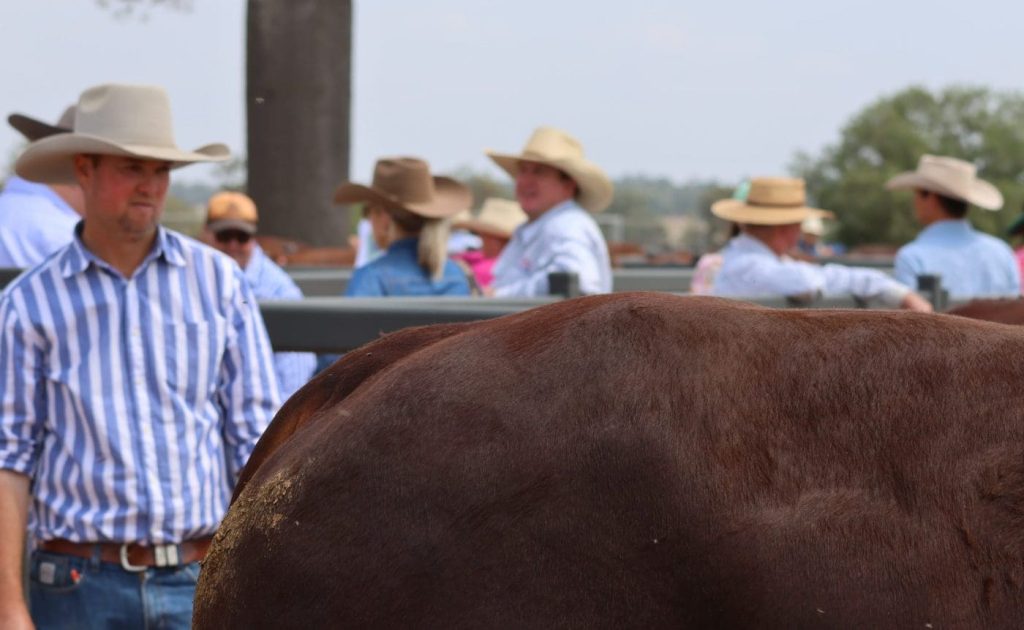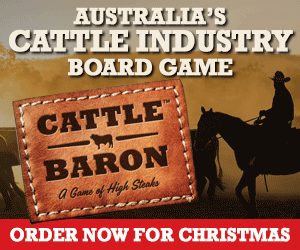
Bull buyers at a Queensland Santa sale earlier this year
THERE were 24,689 stud and herd bulls sold under the hammer this year among the ten largest beef breeds listed in Beef Central’s 2024 annual bull sales summary.
A gradual decline in numbers sold for the same ten breeds is evident over the past two years (see table) with numbers falling by 1408 since our 2022 report, two years ago.
Our 2024 bull sales report includes this summary of numbers of bulls sold and clearance rates, nationally, and a separate article published today discussing average prices paid.
Both 2021 and 2022 bull sale numbers were influenced by national herd rebuilding, however, as the industry recovered after two drought years (2019 across most of eastern Australia, and extending well into 2020 in more northern regions).
As breeder paddocks repopulated, more bulls were required, as a lot of older herd bulls were also liquidated during the drought years.
That cycle is now complete, and bull requirements are now back in equilibrium with breeder numbers, explaining the small retraction this year and last.
Bull numbers sold at auction 2024
For auction results listed in the table above, Angus remains clearly the dominant breed involved, with 11,552 bulls sold at auction this year, or 46.8pc of all bulls sold at auction.
There were 194 Angus bulls sales held across Australia from January to November this year, down from a record 214 last year.
Next largest breed by auction numbers sold this year was Brahman with 2151 bulls sold, followed by Santa Gertrudis on 2023, Hereford with 1930, and Charolais on 1800.
 Again this year’s trends were much less predictable than in the past, with some breeds down 10pc or more in numbers sold compared with last year, while others sharply higher.
Again this year’s trends were much less predictable than in the past, with some breeds down 10pc or more in numbers sold compared with last year, while others sharply higher.
Not all breeds were able to provide clearance rates (bulls sold versus bulls offered), but for those that did, the trend compared with last year was higher – even where the numbers offered has grown. Best performers for clearance were Santa Gertrudis on 92pc, and Charolais, 90pc. Charolais achieved its high clearance rate despite recording the second largest volume of bulls sold in history, surpassed only by the 1823 bulls sold back in 2022. Other breeds ranged from 74pc to 87pc.
At the peak of the post-drought bull demand period back in 2022, clearance rates among the ten largest breeds hit record highs, ranging from a low of 88pc to an extraordinary (perhaps unprecedented) 100pc, for Wagyu.
Trade-in value
Another factor this year has been the solid returns for manufacturing type animals (cows and bulls) suitable for grinding beef and further processing. That end of the market has held up better than higher quality table beef (ie prime steer), helping support trade-in values for used bulls.
Over the past couple of months, heavy bulls have been making 280-300c/kg liveweight at Roma store sales, valuing a 900kg cull bull at $2700. That’s given producers a healthy financial starting point when going into the market for replacements. This time last year, those same bulls were making only 220-240c/kg, valuing bulls at only $1800-$2200.
As noted in Beef Central’s previous annual summaries, caution should be shown in making direct breed ‘comparisons’ over numbers of bulls sold, as any sort of benchmark of breed popularity.
Large tropical breeds like Brahmans and Droughtmasters continue to sell the majority of bulls privately via the paddock, rather than via the auction ring, making any sort of accurate assessment of total bulls used impossible.
The same applies with Wagyu. There’s been a sharp rise in popularity of auction selling to market Wagyu bulls over the past year or two (see earlier Beef Central story), however the overwhelming majority of Wagyu bulls used across Australia continue to be sourced out of the paddock, under private deals.
Season reflected in Angus results
Angus Australia general manager Scott Wright pointed to the momentum being seen in grainfed beef production in Australia as a foundation behind growing Angus bull demand in recent years.
“The numbers of bulls sold and average price may be down a little this year, but they are coming off two exceptional years during herd recovery,” he said.
“It’s said that bull prices are reasonably closely correlated to the EYCI’s performance, and that’s evident this year for Angus. Prices strengthened during the course of the sale season,” he said.
Angus, unlike some other breeds sell across the year from early autumn to late spring.
“Clearances in sales later in the year ended up stronger than earlier sales in the south, when weather was still a big issue. Bull buyers just needed a little more confidence at that time, weather outlook wise,” Mr Wright said.
Sales in July-August faced tough seasonal conditions, and some areas were still nervous about next year’s outlook.
Asked to comment on fewer Angus sales held this year (194 sales reported, down from 207 two years ago), Mr Wright said there appeared to be a little consolidation going on.
“I think some people have chosen to change their marketing mix, and haven’t held an auction sale this year – there’s the same or more animals in the system.”
“Maybe a few people new to bull breeding have said, this is a really hard slog, and perhaps are selling their bulls direct. We think there is a stronger direct market (paddock sales) now for Angus bulls – a lot of our bull breeders have good relationships with bigger clients, selling significant numbers direct.”
Breed registrations supported this, Mr Wright said.
“We got close to 12,000 bull sold at auction at the peak in 2022,” he said. “But at the same time we have 166,000 females on our inventory this year – up 14pc on last year. Doing the simple maths on that tells me that there has to be a lot of bulls going direct – and that’s a good model for a lot of people.”
New Zealand Angus bull breeders had adopted direct selling strongly, he said. “It’s a sensible lower-cost business model for some people – it works quite well,” Mr Wright said.
Record numbers of cattle on feed, and expansion in feedlot capacity across Australia also augered well for future Angus genetics demand, he said.
“Year-on-year, there is still a lot of Angus growth in Queensland, and the feedback we’re getting from members is that they are trying to lift meat quality and fertility.”
2025 Autumn bull selling season call to action for studmasters
Bull breeders wishing to promote their Autumn 2025 bull sales via ads on Beef Central’s genetics pages, daily email alert or home page early next year should contact Nikki Nason via nikki@beefcentral.com phone 0448 630047. Available ad spaces are starting to fill up, so we recommend making contact early to avoid disappointment.
Soon after New Year , work will also start on compiling our full list of 2025 Upcoming Autumn Bull Sales, appearing as a searchable list in Beef Central’s genetics section. We remind studmasters to submit their 2025 autumn sale dates early next year (via this form), if they are not already provided by respective breed societies.
- A number of beef breeds have re-set their record prices for bulls and registered females during 2024. Click this link to access Beef Central’s comprehensive list of breed records.

